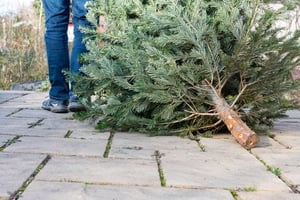 If you put up a live Christmas tree this year, I’m sure you’re enjoying its beauty and fragrant smell. However, once the holiday is over, do you know how to take it down and properly dispose of it? Here’s some information that may help.
If you put up a live Christmas tree this year, I’m sure you’re enjoying its beauty and fragrant smell. However, once the holiday is over, do you know how to take it down and properly dispose of it? Here’s some information that may help.
Taking down your tree
If you’ve watered your tree regularly, hopefully, you’ll be able to enjoy it through the New Year. However, if that’s not the case and your tree is dry and dropping needles, it’s best to take it down early. A dried-out Christmas tree can become a fire hazard. Here are some things that will help with the process.
1. Grab a five-gallon bucket.
A five-gallon bucket will work well for emptying the remaining water in the tree stand. If you don’t have a bucket, visit your local retailer. Retailers, such as Home Depot, sell buckets with handles at an affordable price.
2. Use a plastic tree bag.
You're ahead of the game if you bought a plastic tree bag. If you didn’t buy one, wrap the tree in old sheets or blankets to move it through your home. This can help prevent leaving a trail of needles and sap. If you ever had tree sap on your car, you know it’s hard to remove. It can get extremely messy if you have small children or pets.
3. Get out your broom and dustpan.
If you find vacuuming therapeutic or vacuum your home frequently, you may want to use it to clean up fallen tree needles. Unfortunately, tree needles can clog your indoor vacuum and even cause damage. For this job, a broom and dustpan will work best. A wet/dry vacuum with a lot of power and a wide hose may also work well.
Recycling your tree
Once the tree is outside and your home is cleaned, it’s time to dispose of it.
1. Contact your local public works department.
Depending on where you live, your DPW may provide curbside pickup for several weeks after Christmas. In addition, if your city has a collection center, you can drop it off there. Trees and other wood products collected can be shredded and turned into mulch for use by city residents when the weather gets warmer.
2. Set it up in your backyard.
Leaving it in your yard during winter can provide shelter for birds and other small mammals.
3. Use the branches as cover.
If winter is tough on your perennials, the tree branches can protect them.
4. Start a compost pile.
My neighbor started a compost pile several years ago and let us use it. If you want to create your own, tree branches make a great base because they allow airflow.
5. Throw it into your pond.
If you have a pond, you could cut the tree into smaller sections and throw it in the water to serve as an excellent habitat for fish. If it’s not your pond, have permission before dumping it.
6. Donate it to your local fishing club.
Where I grew up, fishing clubs have used trees for years to make lake navigation more accessible and safer. Once the lake is frozen, roads are lined with trees to identify where vehicles can drive. They’re also used to mark the mileage from the shore.
7. Check with your local animal rescue.
Depending on the size and type of the animal, trees can be used for enrichment programs.
I hope you have a great holiday season and wish you a safe and prosperous new year.





